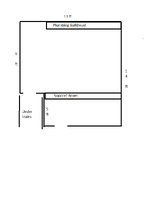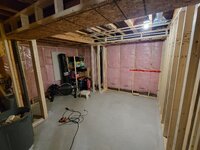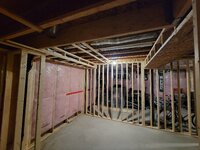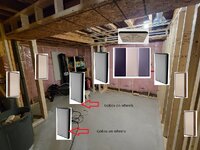Kapo_Polenton
Well-known member
Ok, so I'm finally getting down to finishing the basement at the house we moved into 4 years ago. Unfortunately, all the downsides to a basement studio apply on this one. I have a plumbing stack in my studio space, an I beam running through it, and I had to build a wall off the stairs to help cut down on sound transfer. In short, it isn't ideal but I am also doing a living room/ play area for my kids and have a small gym space and then storage. I'm planning double 5/8 drywall and resilient channel everywhere in the room but obviously I am going to have a weak spot in the 2 doors as my wife still wanted access to emergency supplies under the stairs.
I've used staggered inner walls and a wall within the stairs framing. Duct work is going to be flexible and run in S shape within the joists. Luckily my spot is the furthest away from the furnace but obviously, duct work projects sound.
Despite all the short comings, I am looking forward to having a space I can decorate and play guitars/drums in. Will the bass drum still transfer? Absolutely. But I'm assuming that during the day if the house is a bustle, I am significantly reducing the boom without setting off the glass break sensor panel every time i hit a crash cymbal. So given that and my unique challenges, where would you set up your listening/mixing position? The room is L shaped so I plan to set up faux walls with Gobo's on wheels.
Do you go between the plumbing stack bulkhead so you can do bass traps in the corners? Or do you take the wider wall between the two bulk heads? Interested in everyone's perspective.
I've used staggered inner walls and a wall within the stairs framing. Duct work is going to be flexible and run in S shape within the joists. Luckily my spot is the furthest away from the furnace but obviously, duct work projects sound.
Despite all the short comings, I am looking forward to having a space I can decorate and play guitars/drums in. Will the bass drum still transfer? Absolutely. But I'm assuming that during the day if the house is a bustle, I am significantly reducing the boom without setting off the glass break sensor panel every time i hit a crash cymbal. So given that and my unique challenges, where would you set up your listening/mixing position? The room is L shaped so I plan to set up faux walls with Gobo's on wheels.
Do you go between the plumbing stack bulkhead so you can do bass traps in the corners? Or do you take the wider wall between the two bulk heads? Interested in everyone's perspective.




